Linguine with clams, also known as Linguine alle Vongole is a true Italian seafood classic. If you ask me, it is probably the simplest yet best seafood pasta there is. If you’re looking for one of the best seafood pastas for you and your loved ones that is prepared in less than 20 minutes, then this recipe is for you!
In this article, you will learn how to make authentic Linguine with clams like in Italy. I’m also covering how to treat, store, and cook the clams and a step-by-step cooking guide on how to make Linguine alle Vongole. This way, you’ll end up with a fantastic plate of pasta with clams full of flavors and deliciousness from the sea.
Linguine with Clams – Table of contents
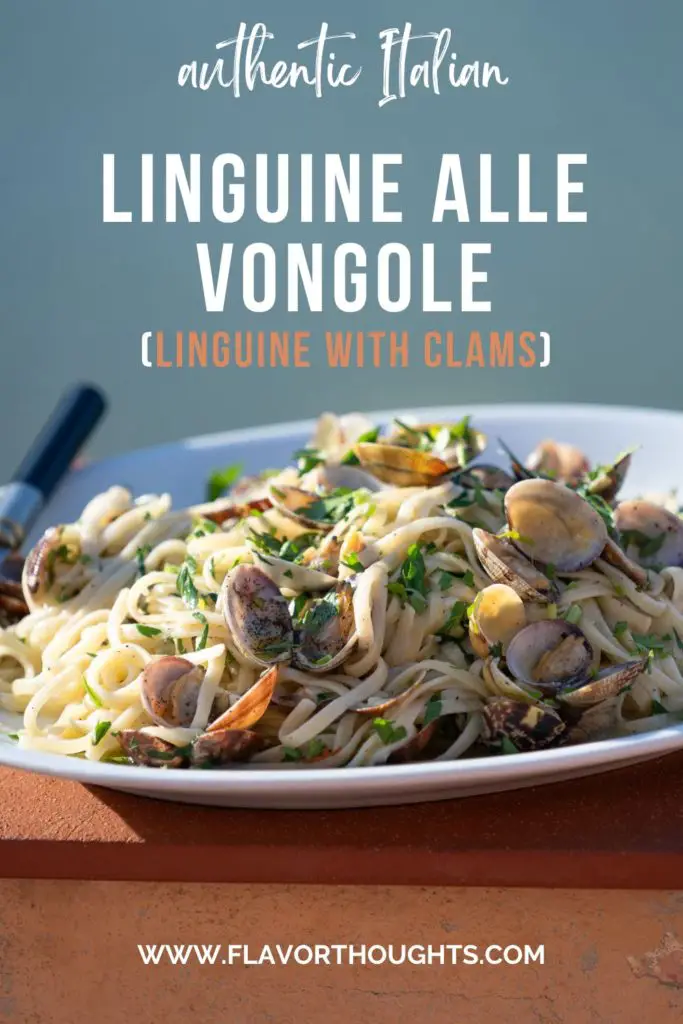
Key Points for a Successful Pasta alle Vongole
Although Linguine with clams is a rather simple pasta recipe to make, there are a few key points to mention to end up with the best results.
Use fresh clams
As with any recipe, the food will only be as good as its ingredients. When using seafood or clams in this case, this is even more important. As the clams are the key ingredient and responsible for the desired taste of the sea, we need to get as fresh clams as possible. The best case would be to get them fresh from the fish market.
There are several recipes out there using canned clams, but this won’t taste anywhere near as good as fresh and real pasta vongole in Italy. If you can’t get fresh veraci clams, you can also use other types like littleneck clams, manila clams, or cockles clams. Just use the one you can find, the main thing is that they are fresh. If possible, cook them on the same day you buy them, or at most the day after.
Use a large sauté pan
Another key factor when cooking clams is to use a large enough pan. In order for the clams to open up and cook evenly, they need to have enough space. They should have enough room to evenly come in contact and sauté with the other ingredients like the wine, olive oil, and garlic.
Thus, the clams can release moisture which results in a proper flavor distribution between the clams and the bryne / sauce. If the pan is overcrowded, some clams do simmer while others are being steamed. This results in uneven cooking and texture.
The best pan you could use is a large sauté pan or a wide and deep Italian pasta pan with a lid I’m using in this recipe. However, you can also just use a large and deep skillet which you can cover with a lid.
You can then finish cooking the pasta in the same pan, for which space must also be taken into account. This is also the reason, why these large Italian aluminum pans are called pasta pans, as the pasta is often cooked in the sauce until al dente.
Avoid overcooking the clams
This goes together with the point mentioned above. To avoid overcooking the clams, you first have to use a large enough pan to ensure an even cooking. Secondly, it is important not to cook the clams for too long.
I suggest leaving the lid on and giving the pan a swirl from time to time in the first 3-4 minutes. Then check if the majority of the clams opened up. The cooking time will be different regarding the type of clams you choose.
To avoid overcooking, I’m setting the cooked clams aside and just finish cooking the pasta in the white clam sauce as explained in more detail in the cooking process below.
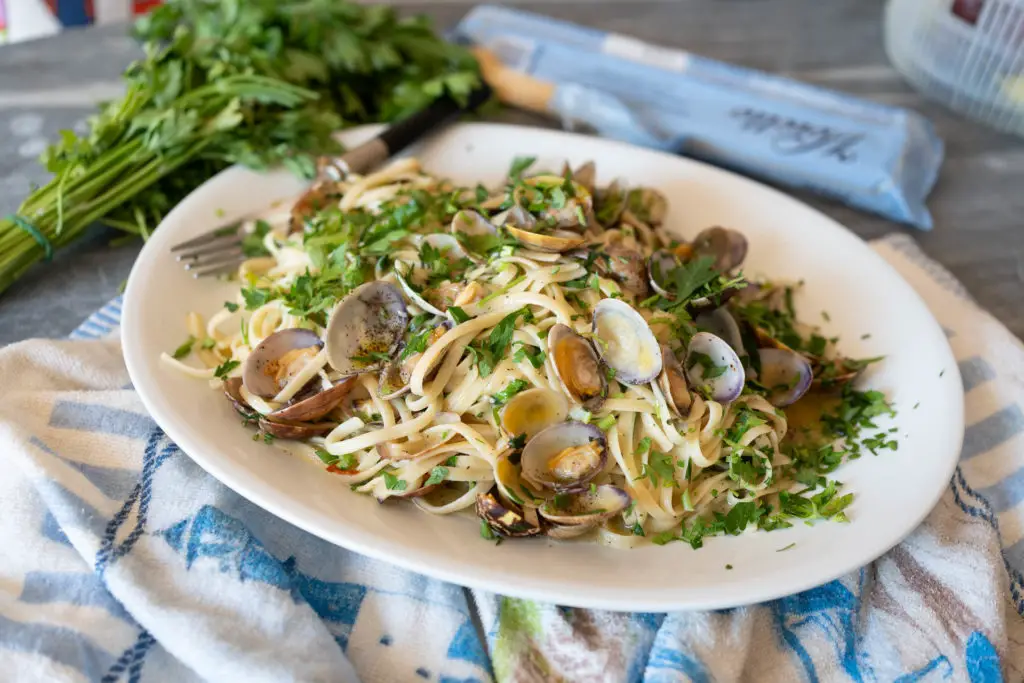
The ingredients you need for an authentic Linguine alle Vongole
Although pasta alle vongole is one of the simplest Italian pasta, including only 7 ingredients, it is important that these ingredients are of the best quality you can get. These are the following ingredients you need for my Linguine with clams recipe:
- Clams
The most traditional and commonly used type of clam used in Italy for Linguine alle vongole is the veraci clam. These small clams about 5cm wide are farmed in the Adriatic Sea and have a sweet, delicate, and salty taste. However, you can also use manila clams, cockles, or littleneck clams for your best linguine alle vongole. The main thing is to get fresh clams and not canned clams! - Linguine
Long pastas are mostly used for this recipe. Although spaghetti is the most used type of pasta for pasta alle vongole, Linguine might be just behind. I like to use Linguine as they’re a little wider and thus tend to hold a little more of the sauce. For sure you can use the type of pasta you like, as long it’s quality pasta, you can’t do anything wrong. - White Wine
To get this briny and lovely white clam sauce, white wine is used together with starchy pasta water, cooking liquid from the clams, and olive oil. The key is to use a dry white wine like Pinot Grigio or Sauvignon blanc. You don’t need the most expensive one for cooking, just choose a wine you would actually drink too. The wine also gives an acidic counterpart to the spiciness of the chili and sweet- and saltiness of the clams. - Italian Peperoncino / red pepper flakes
For a subtle heat, you can use two small and dried Italian Peperoncini chilis or one small and fresh one. You can also just use another kind of hot red pepper flakes. - Garlic cloves
The fresh garlic should support the dish with its flavors, but not overwhelm it with its aroma. To not overpower the pasta vongole with its fragrance, it is important not to use too much garlic and to use it in different ways and steps in the cooking process. - Fresh Parsley
A pinch of chopped flat-leaf parsley adds a herb and fresh note to the dish. Also is parsley great to garnish the plate of pasta in the end. - Olive Oil
Last but not least, a great quality olive oil as almost always in the Italian and Mediterranean kitchen.
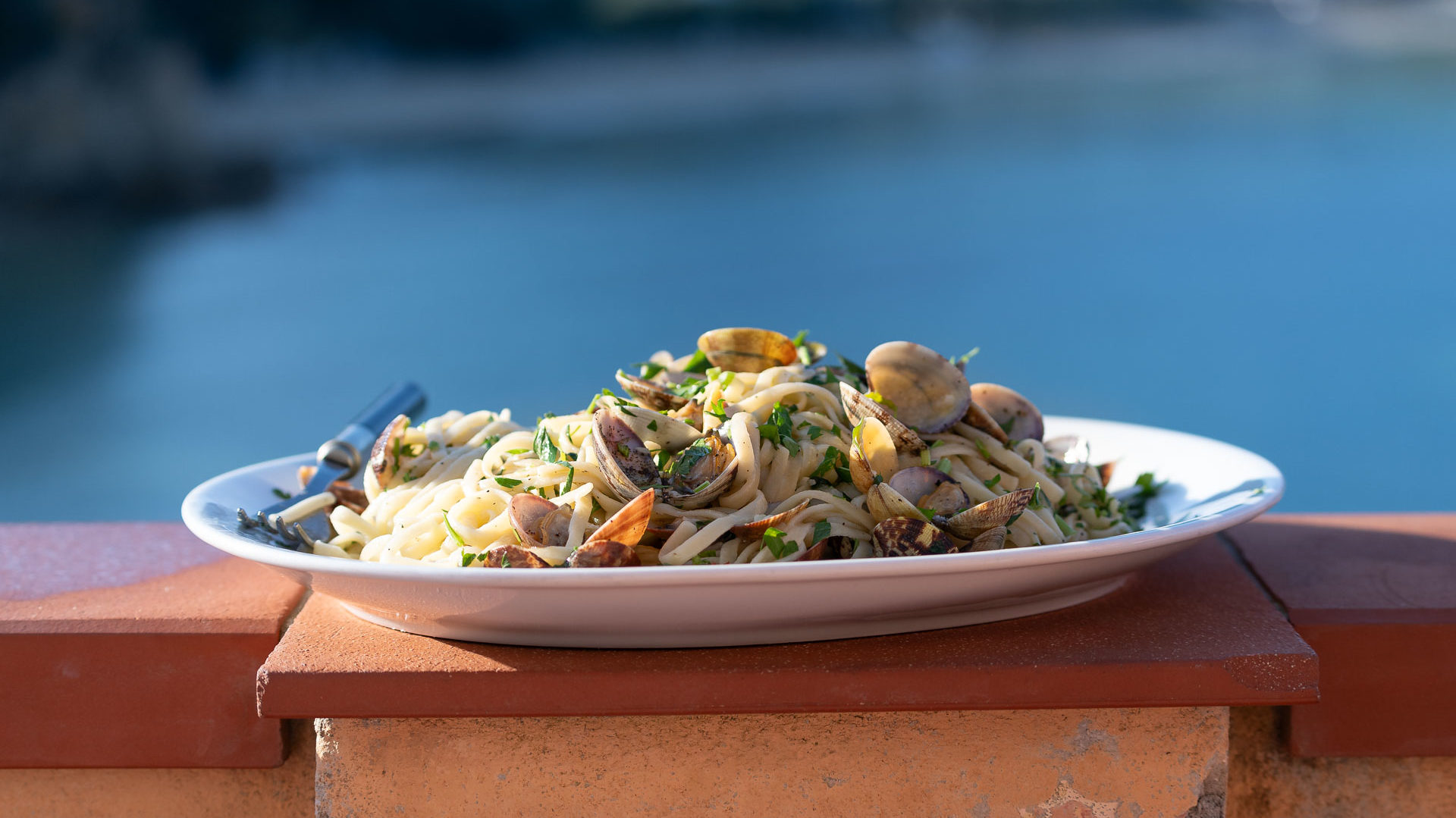
How to make the best Linguine with clams – Step-by-Step Guide
Linguine and clams is a pasta recipe that is rather simple to make as long as you stick to a few key points in the cooking process. Following are step-by-step instructions on how to prepare this delicious Italian pasta dish.
If you would rather watch the recipe instead of reading it, you can jump to my Video Recipe below.
Step 1: Preparations
Wash and Purge the clams
One of the first things to do is to properly wash and purge the clams. Soaking them in cold salt water helps to purge them from inside sand and grit. You don’t necessarily need to do that if you bought your clams super fresh from a place where they pre-purged them already.
This was also the case when I bought mine fresh in Italy for the video recipe and I couldn’t find any residues while eating them. However, if you have the time or if you aren’t sure about the condition of the clams, I suggest doing this step. You can read below how to purge clams.
Except for purging/soaking them, just give them a good wash under cold running water to remove any parts on the shells.
You can also set up the cooking water for the pasta now if you like.
remove the dead, cracked, or wide-opened clams
Let the clams one by one drop on a hard surface to check for any cracked shells. Remove all clams with cracked shells and the ones that are wide-open and not closing when touching them. A dead clam might add unwanted, unpalatable flavors to the sauce while cooking them.

Step 2: Cooking the Clams
Preparing the aromatics
Separate the parsley stems from the leaves and put the leaves aside for later. Crush half of the fresh garlic cloves with your knife. The garlic should just add a little flavor, but not too much at this point. This is why we’re crushing it instead of finely chopping or grinding it. For the dried pepperoncini, just roughly chop them.
Time to cook the clams
Set a large and wide pan to medium heat, add half of the olive oil, and fry the three ingredients above for 1-2 minutes. Now add the clams and turn up the heat. After 1-2 minutes, add the white wine and close the pan with a lid. Cook the clams for about 4-5 minutes or until they opened. Be sure to give the pan a quick swirl from time to time.
Remove dead clams and filter the clam broth
When the majority of clams open, turn off the heat. Now remove all unopened clams as well as the parsley stems. When done, filter the clams from the lovely and juicy sauce with a sieve. Keep both separate and put them aside for later.
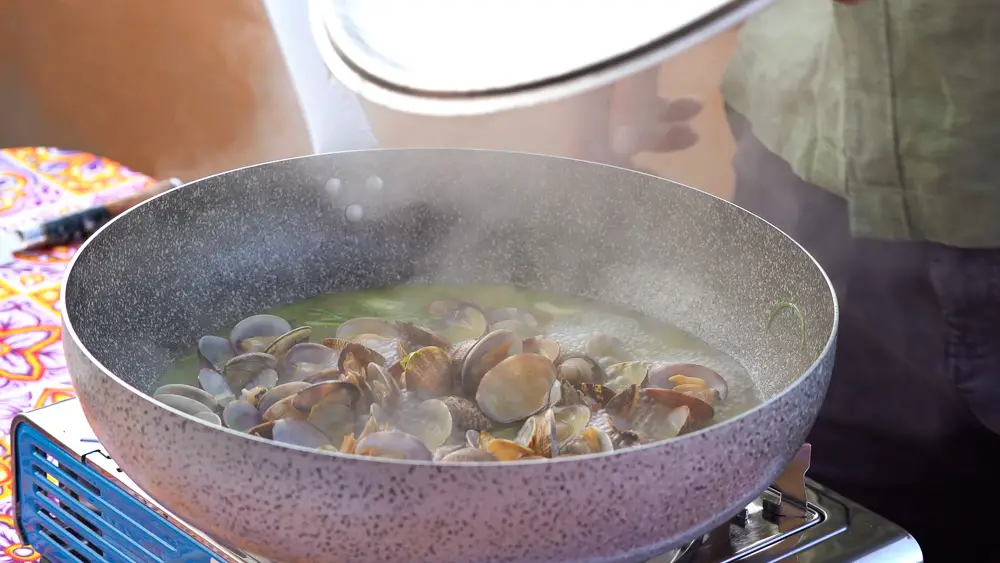
Step 3: Finishing the Linguine with clams
Cook Linguine
If not already set up, you can now add the pasta to the boiling water. Just cook the Linguine halfway through (like 4 min less than mentioned) as the pasta will finish cooking in the clam broth.
Finishing the pasta
Finely chop the second half of the garlic cloves. Set the pan to medium-high heat again and add the remaining olive oil. Add the minced garlic and add the pasta with a slotted spoon before the garlic is going to burn.
Give everything a good mix and add the briny juice from the clams. Cook the pasta in the juice for 2-3 more minutes and also add a little starchy cooking water. When the Linguine is al dente and the sauce is greasy and more on the runny side, add the clams so most of the chopped parsley. You don’t need to add a lot of additional salt, but you can also add a pinch of kosher salt and some black pepper.
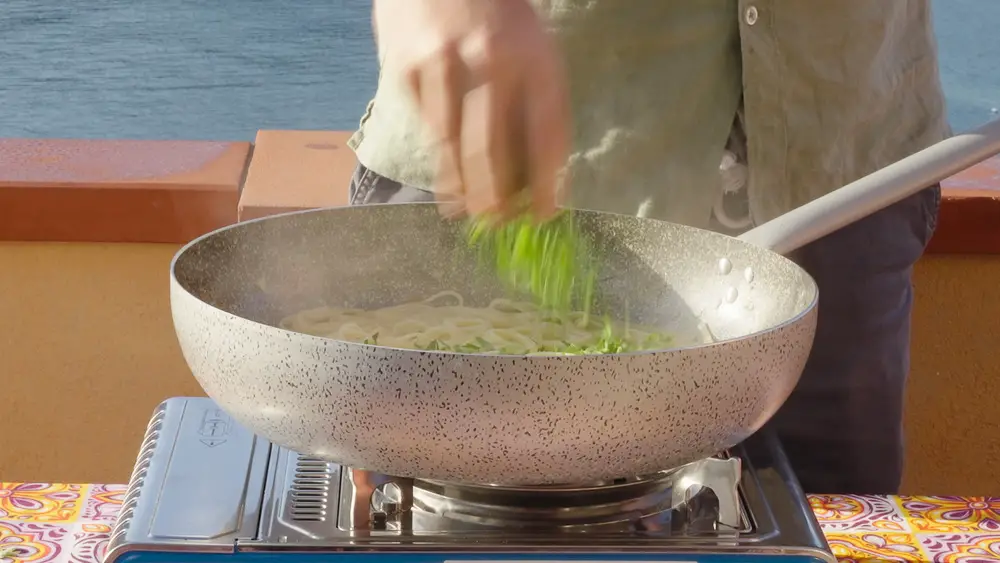
Step 4: Serving
Serve the finished pasta on two separate or one large serving plate. Garnish with the remaining parsley and drizzle a little olive oil to finish it up. You can also sprinkle some fresh lemon juice or some lemon zest if you like.
Enjoy an incredible plate full of flavors of the sea!
Watch how to make this Linguine alle Vongole – Video Recipe
Frequently Asked Questions for Linguine with Clams
How do you clean clams for Linguine and clam sauce?
You can both clean the clams from the outside under running water and from the inside by soaking them in water to purge them. To do so, put the clams in a large bowl of cold water, and generously add salt. Put the bowl in a fridge for 1 hour and the clams will start to spit out the sand and grit inside the shells. If needed, change the water and repeat for 1-2 more times.
Should you soak clams before cooking?
If you have the time or if you’re unsure about the pre-purging process of the seller, I suggest soaking and purging the clams for 1-2 hours in cold water.
How do you know if clams are bad before cooking
Clams that are wide open and not close when tapped are dead and should be removed. The same is suggested with clams having cracked shells. Except for that, you will notice a foul, unpleasant, and eggy smell if they turn bad. After cooking them, remove all unopened clams.
How long does Linguine with clams last in the fridge – Storage
Cooked Linguine with clams can be stored in the fridge for up to 3-4 days and up to 2-3 months in the freezer.
More Italian Pasta Recipes you might like
- Linguine Puttanesca
- My favorite, slightly spicy Summer Pasta with a fresh kick!
- Pasta alla Gricia, the most underrated and oldest of the four classic roman pastas
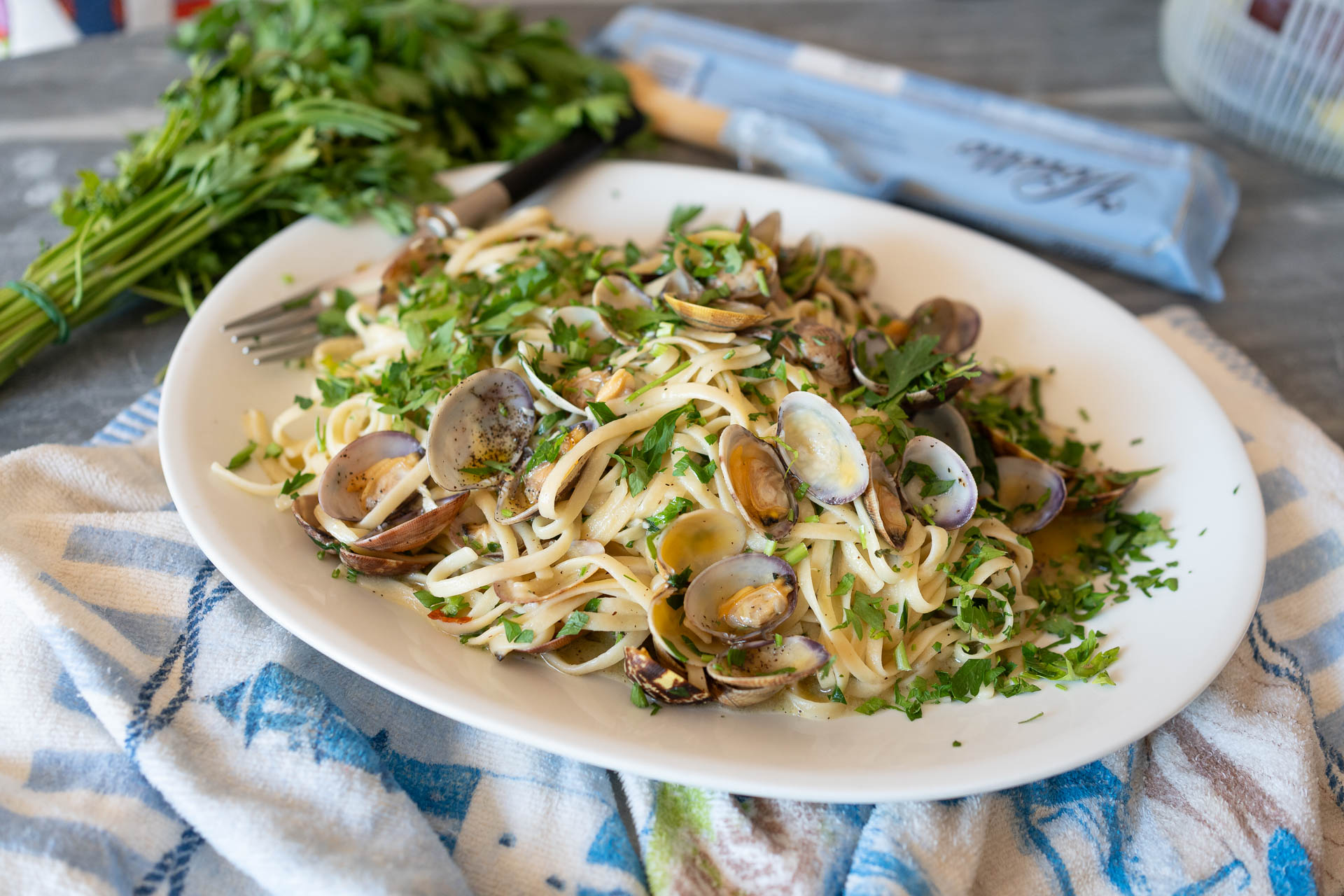
Linguine with Clams
Equipment
- 1 large saute pan or other wide & deep skillet
Ingredients
- 500 grams clams veraci, littleneck, manila or cockles
- 250 grams Linguine
- 150 ml dry white wine
- 1-2 Italian Peperoncini chilis or 1 fresh one
- 10 tbsp olive oil
- 1 handful fresh parsley
- 2 cloves garlic
- 1 pinch salt & pepper
Instructions
Wash, purge and check the clams
- Wash the clams on the outside under running water and remove any sand. To purge the inside of the clams, put them in a bowl of cold, generously salted water. Put the bowl in the fridge for an hour. The clams will start to spill out snad and grit. Repeat with new water 1-2 times if necessary.500 grams clams
- Now let the clams drop one by one of a countertop or other hard surface. Remove all clams that have a cracked shell and also the ones that are wide open, not closing when tapping them.
Cooking the Clams
- Separate the parsley leaves from the stems and put them aside for later. Cut the stems into smaller parts and give half of the garlic cloves a quick crush with your knife. For the dried chilis, just roughly chop them.1 handful fresh parsley, 2 cloves garlic, 1-2 Italian Peperoncini chilis
- Put a large and deep saute pan on medium heat, add half of the olive oil so as the garlic, parsley stems and chilils. Fry them for 1-2 minutes and then add the clams and turn up the heat. Now add the white wine and close the pan with a lid.10 tbsp olive oil, 150 ml dry white wine
- Cook the clams for 4-5 minutes or until the majority of them opened. Depending on the type of clam you use, the cooking time could be longer or shorter. Be sure to shake the pan a little from time to time. When the clams are done, turn off the heat.250 grams Linguine
- Remove all unopened clams and also the parsley stems. Now filter the clam broth through a sieve and keep both, clams and juice seperately for later.
Cooking the Linguine
- Now cook the Linguine in salted water only half way through or about 4min less than mentioned on the package. The paste will finish cooking in the clam broth later.
- Finely chop the second half of the garlic cloves so as the parsley leaves. Put the large sauté pan or skillet to medium-high heat again and add the remaining olive oil. Now add the garlic and add the pasta with a slotted spoon a few seconds later. Be careful not to burn the minced garlic.Now add the lovely smelling broth from the clams and cook the paste for about 3 more minutes or until al dente. Also add a little from the starchy pasta water.
- When the pasta is ready, add the clams again so as most of the chopped parsley. Give the pasta a pinch of pepper and salt and mix well together.1 pinch salt & pepper
Serving the Linguine alle Vongole
- Arrange the pasta directly onto the indiviudal plates or on a large pasta plate. Garnish with the remaining parsley and sprinkle with some olive oil.Now enjoy that fantastic portion of seafood pasta you just created.

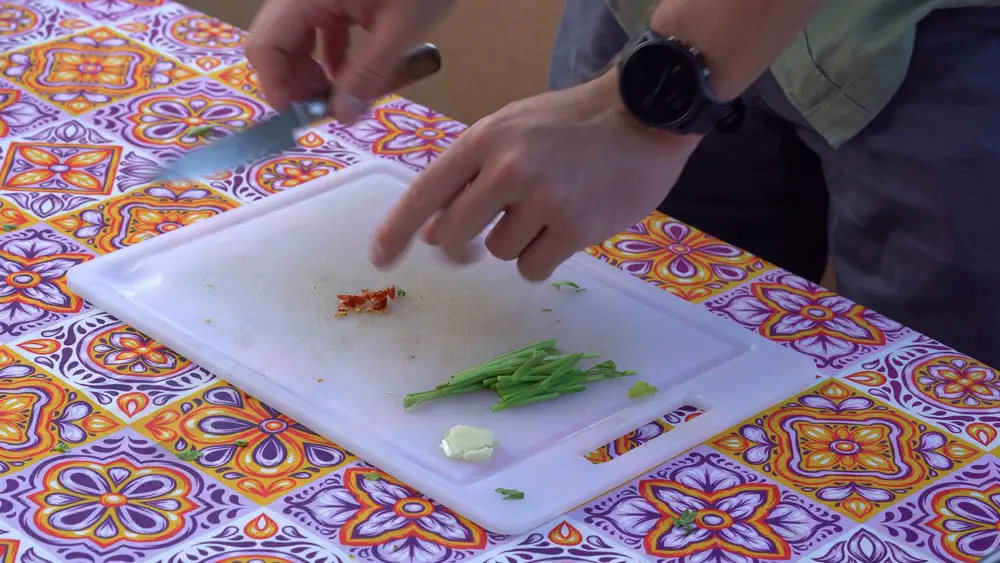
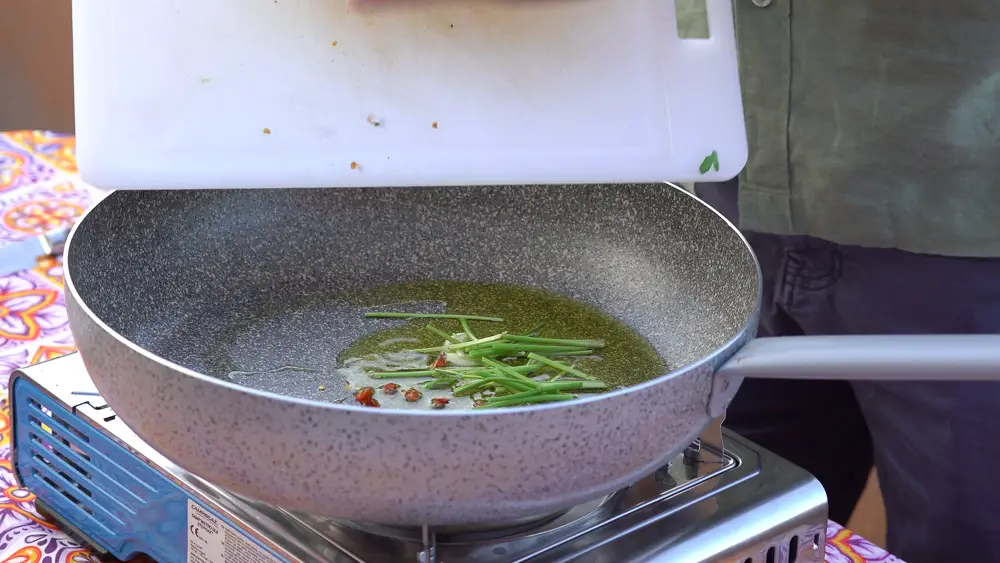
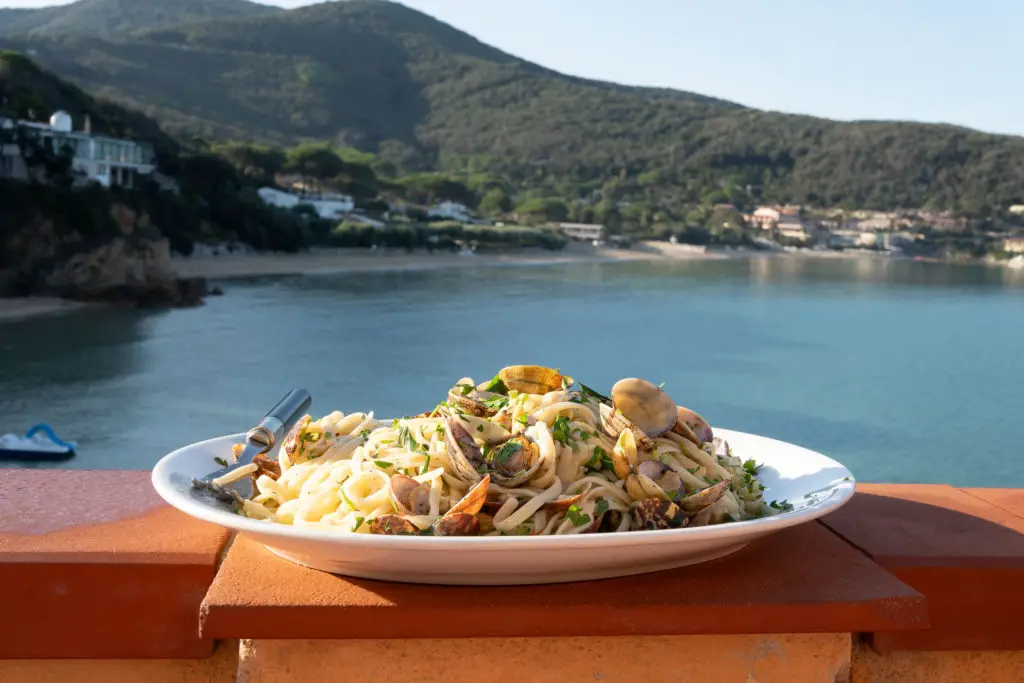
This is always been a favourite of mine and I’ve been cooking it since I was a teenager. After using the Fresh clams and shell, I also use two small cans of chopped clams and I retain the clam juice and the clam juice will go in with the reduction of the fresh clams as they open, this for folks like myself who really loved the extra clams. Now don’t cringe but when everything is sauced in the pan I will add a quick sprinkling of fine grated parmigiano Reggiano! It’s amazing how it will thicken this sauce And incredible richness finish off with fresh ground black pepper thanks for listening
Thanks a lot Robert for your comment and wathing by on my Blog an recipes. Interesting to hear how other are preparing their linguine with clams, and a good approach with the half-half version with canned clams as well to get some more meat in the pasta. All the best mate and keep having fun cooking!